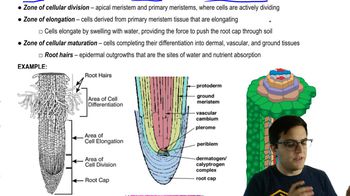Table of contents
- 1. Introduction to Biology2h 42m
- 2. Chemistry3h 40m
- 3. Water1h 26m
- 4. Biomolecules2h 23m
- 5. Cell Components2h 26m
- 6. The Membrane2h 31m
- 7. Energy and Metabolism2h 0m
- 8. Respiration2h 40m
- 9. Photosynthesis2h 49m
- 10. Cell Signaling59m
- 11. Cell Division2h 47m
- 12. Meiosis2h 0m
- 13. Mendelian Genetics4h 44m
- Introduction to Mendel's Experiments7m
- Genotype vs. Phenotype17m
- Punnett Squares13m
- Mendel's Experiments26m
- Mendel's Laws18m
- Monohybrid Crosses19m
- Test Crosses14m
- Dihybrid Crosses20m
- Punnett Square Probability26m
- Incomplete Dominance vs. Codominance20m
- Epistasis7m
- Non-Mendelian Genetics12m
- Pedigrees6m
- Autosomal Inheritance21m
- Sex-Linked Inheritance43m
- X-Inactivation9m
- 14. DNA Synthesis2h 27m
- 15. Gene Expression3h 20m
- 16. Regulation of Expression3h 31m
- Introduction to Regulation of Gene Expression13m
- Prokaryotic Gene Regulation via Operons27m
- The Lac Operon21m
- Glucose's Impact on Lac Operon25m
- The Trp Operon20m
- Review of the Lac Operon & Trp Operon11m
- Introduction to Eukaryotic Gene Regulation9m
- Eukaryotic Chromatin Modifications16m
- Eukaryotic Transcriptional Control22m
- Eukaryotic Post-Transcriptional Regulation28m
- Eukaryotic Post-Translational Regulation13m
- 17. Viruses37m
- 18. Biotechnology2h 58m
- 19. Genomics17m
- 20. Development1h 5m
- 21. Evolution3h 1m
- 22. Evolution of Populations3h 52m
- 23. Speciation1h 37m
- 24. History of Life on Earth2h 6m
- 25. Phylogeny2h 31m
- 26. Prokaryotes4h 59m
- 27. Protists1h 12m
- 28. Plants1h 22m
- 29. Fungi36m
- 30. Overview of Animals34m
- 31. Invertebrates1h 2m
- 32. Vertebrates50m
- 33. Plant Anatomy1h 3m
- 34. Vascular Plant Transport1h 2m
- 35. Soil37m
- 36. Plant Reproduction47m
- 37. Plant Sensation and Response1h 9m
- 38. Animal Form and Function1h 19m
- 39. Digestive System1h 10m
- 40. Circulatory System1h 57m
- 41. Immune System1h 12m
- 42. Osmoregulation and Excretion50m
- 43. Endocrine System1h 4m
- 44. Animal Reproduction1h 2m
- 45. Nervous System1h 55m
- 46. Sensory Systems46m
- 47. Muscle Systems23m
- 48. Ecology3h 11m
- Introduction to Ecology20m
- Biogeography14m
- Earth's Climate Patterns50m
- Introduction to Terrestrial Biomes10m
- Terrestrial Biomes: Near Equator13m
- Terrestrial Biomes: Temperate Regions10m
- Terrestrial Biomes: Northern Regions15m
- Introduction to Aquatic Biomes27m
- Freshwater Aquatic Biomes14m
- Marine Aquatic Biomes13m
- 49. Animal Behavior28m
- 50. Population Ecology3h 41m
- Introduction to Population Ecology28m
- Population Sampling Methods23m
- Life History12m
- Population Demography17m
- Factors Limiting Population Growth14m
- Introduction to Population Growth Models22m
- Linear Population Growth6m
- Exponential Population Growth29m
- Logistic Population Growth32m
- r/K Selection10m
- The Human Population22m
- 51. Community Ecology2h 46m
- Introduction to Community Ecology2m
- Introduction to Community Interactions9m
- Community Interactions: Competition (-/-)38m
- Community Interactions: Exploitation (+/-)23m
- Community Interactions: Mutualism (+/+) & Commensalism (+/0)9m
- Community Structure35m
- Community Dynamics26m
- Geographic Impact on Communities21m
- 52. Ecosystems2h 36m
- 53. Conservation Biology24m
33. Plant Anatomy
Growth
Problem 5`
Textbook Question
The vascular cambium gives rise to
a. All xylem
b. All phloem
c. Primary xylem and phloem
d. Secondary xylem and phloem
 Verified step by step guidance
Verified step by step guidance1
Understand the role of the vascular cambium: The vascular cambium is a type of lateral meristem in plants responsible for the production of secondary growth, which increases the thickness of stems and roots.
Differentiate between primary and secondary growth: Primary growth occurs at the apical meristems and results in the elongation of the plant, while secondary growth, facilitated by the vascular cambium, results in the thickening of the plant.
Identify the products of the vascular cambium: The vascular cambium produces secondary xylem (wood) and secondary phloem, contributing to the plant's increased girth.
Clarify the distinction between primary and secondary tissues: Primary xylem and phloem are produced by the apical meristems during primary growth, whereas secondary xylem and phloem are produced by the vascular cambium during secondary growth.
Conclude which option is correct: Based on the understanding that the vascular cambium produces secondary xylem and phloem, identify the correct answer from the given options.
 Verified video answer for a similar problem:
Verified video answer for a similar problem:This video solution was recommended by our tutors as helpful for the problem above
Video duration:
1mPlay a video:
Was this helpful?
Key Concepts
Here are the essential concepts you must grasp in order to answer the question correctly.
Vascular Cambium
The vascular cambium is a type of lateral meristem in plants responsible for the production of secondary vascular tissues. It is a cylindrical layer of cells that divides to produce secondary xylem (wood) on the inside and secondary phloem on the outside, contributing to the thickening of stems and roots in woody plants.
Recommended video:
Guided course

Seedless Vascular Plants
Secondary Growth
Secondary growth refers to the increase in thickness or girth of plant stems and roots, primarily in woody plants. This growth is facilitated by the vascular cambium and cork cambium, which produce secondary xylem and phloem, and cork, respectively. Secondary growth is crucial for the structural support and transport of nutrients and water in mature plants.
Recommended video:
Guided course

Secondary Growth
Primary vs. Secondary Xylem and Phloem
Primary xylem and phloem are formed during the initial growth phase from the apical meristems, contributing to the elongation of the plant. In contrast, secondary xylem and phloem are produced by the vascular cambium during secondary growth, increasing the plant's thickness. Understanding the distinction is essential for identifying the roles of different plant tissues in growth and nutrient transport.
Recommended video:
Guided course

Primary and Secondary Immunity
Related Videos
Related Practice





















